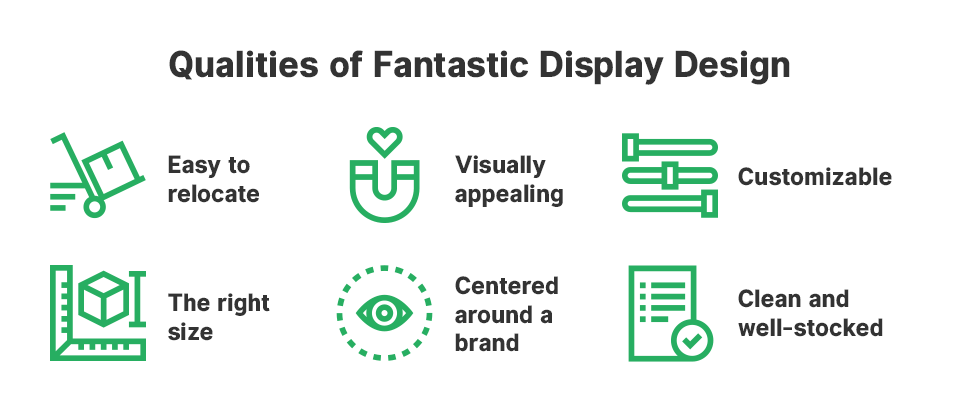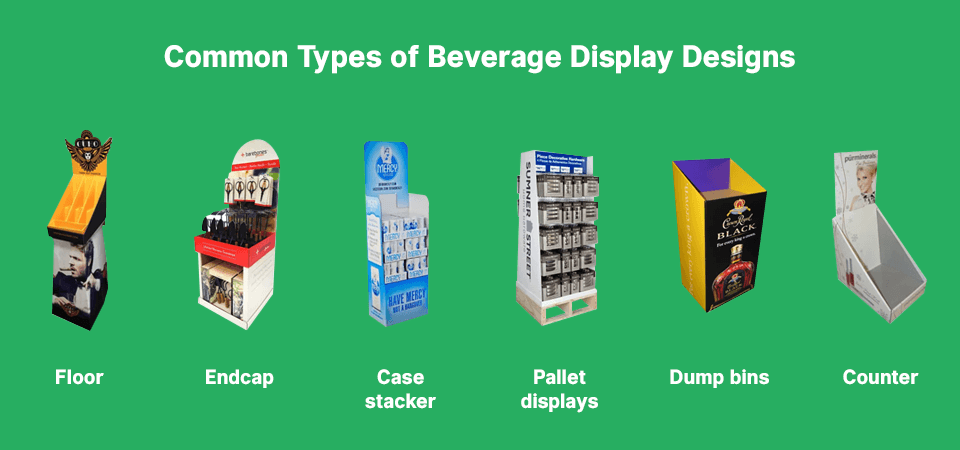Chapter 2: What Makes a Good Display?
A store display must possess specific characteristics to capture customers’ attention. First, retail displays need to be durable yet lightweight. For this reason, they are often made of premium corrugated cardboard.
Corrugated cardboard consists of multiple layers and is tough, portable and easy to assemble. This type of material is frequently used for point-of-purchase displays because it’s also customizable and can be printed with any design you dream up. Corrugated cardboard displays are ideal for promoting new products and seasonal items.
It’s equally important that displays are colorful, attractive and encourage customers to interact with unfamiliar brands. Displays offer an easy way to make your products stand out and get noticed.
If you’ve never designed a display before, or feel you need a refresher, keep reading. This chapter introduces you to in-store display design and the various types of corrugated cardboard beverage displays.
Qualities of Fantastic Display Design
As someone who works in the food and beverage industry, you probably know that competition is fierce. There are about 31,401 food and beverage processing companies in the United States. In addition, thousands of new food and beverage products are introduced in retail outlets each year. Beverages account for the greatest percentage of new products, followed by snacks and bakery foods.
Beverage companies must set themselves apart from competitors to stick in shoppers’ minds. Beverage displays help make that possible. A great display is meant to draw attention to a product, so it must have certain qualities. A display should be:
- Easy to relocate: Great displays are easy to pick up and move to another part of the store. Retailers frequently rearrange displays to keep their stores fresh and create new experiences for their customers. As a supplier, you might ask a retailer to move your display to a busy store section.
- Visually appealing: The primary purpose of a display is to attract customers to the product. To serve its purpose, a display should be creative, pleasing and memorable. After all, you want customers to purchase your product or remember your brand for future shopping experiences.
- Customizable: When working with a display manufacturer, you should have the option to create a custom display. You want to produce a display that’s made specifically for your unique brand, and a generic design won’t make the grade.
- The right size: A good display can hold the right amount of merchandise — not too much or too little. You don’t want the display to look crammed with items, nor do you want it to be too large for the merchandise and make it seem as if things are out of stock.
- Centered around a brand: An amazing display is built around a brand and clearly communicates its personality. Customers should have no trouble identifying a brand’s unique traits when they look at the display, and the target audience should feel an immediate connection.
- Clean and well-stocked: Displays need to make a positive first impression. This means displays should be kept well-stocked and free of garbage, dust and dirt.
Common Types of Beverage Display Designs
Beverage displays are not one-size-fits-all, and they come in a range of shapes and sizes to suit the product. Stores often have a variety of displays to create a more organized and exciting space. Common beverage displays include:
- Floor: A floor display is a freestanding unit designed to attract customers as they move through the store. It encompasses the types of displays listed below but may also include a completely unique structure. Floor displays often stand at eye-level, so customers are sure to see the advertised products.
- Endcap: Endcap displays are placed at the end of an aisle run. Endcaps increase beverage sales because customers view endcap products as value-priced items, even if they aren’t on sale. Endcap displays also appeal to consumers’ desire to save time. According to one study, endcaps account for an estimated 30% of supermarket sales. Seasonal products, sale items and new beverages all belong in endcap displays.
- Case stacker: Case stackers are often used to display non-alcoholic and alcoholic beverages in a store. These displays allow merchandisers to stack cases of the product. Case stackers may be placed at the end of an aisle to draw attention or used as a floor display to save space.
- Pallet displays: Pallet displays allow retailers to promote large quantities of products. These displays are custom-designed to fit on a pallet and enable the store to stack items. Pallet displays are often used for seasonal items and to create a sense of urgency.
- Dump bins: Dump bins usually go in the center of a wide aisle. This type of display allows merchandisers to “dump” a large number of products in the bin. Usually, dump bins are used to sell a single product — typically items on sale. However, you can use dump bins any time you want to sell something fast. Like pallet displays, dump bins create a sense of urgency and encourage impulse buys.
- Counter: Counter displays await customers at the checkout line. These displays are small and designed to sit on a counter or shelf. Counter displays are ideal for prompting impulse buys, and they are often used for consumable items.
If you have more questions about the types of beverage displays available, we’ll be happy to help at Creative Displays Now.



